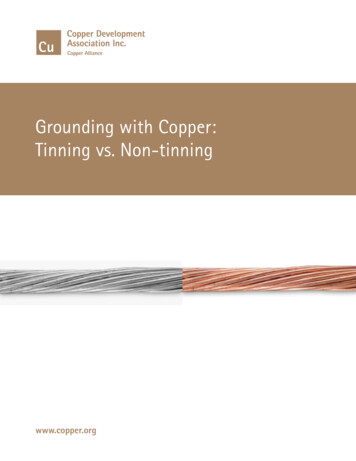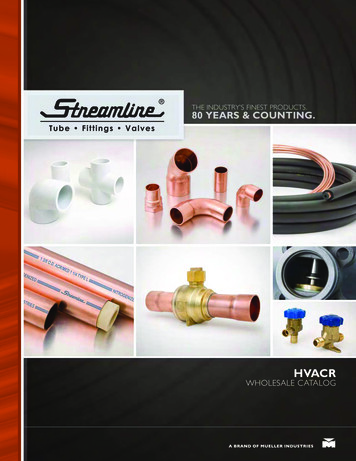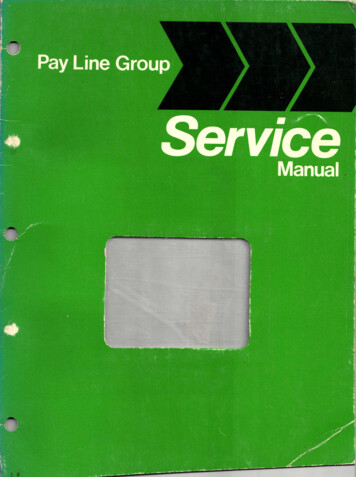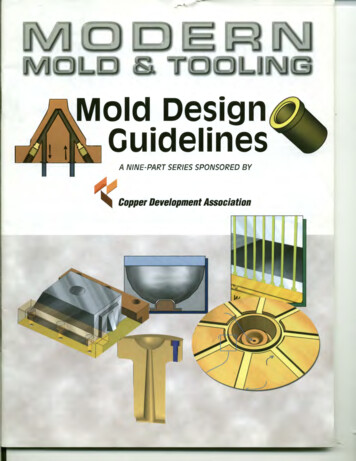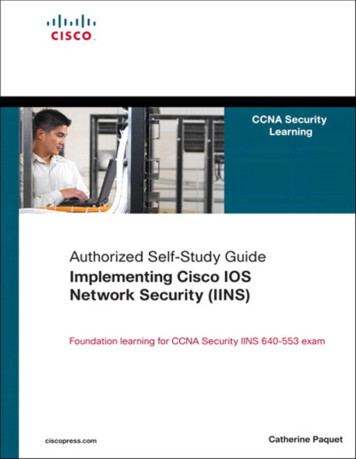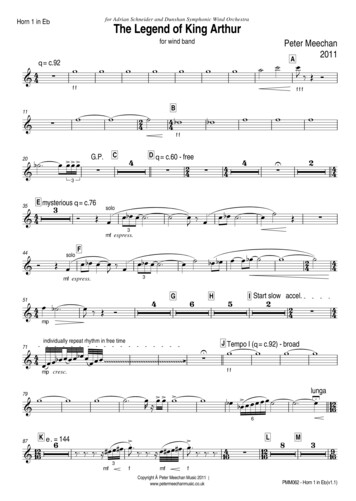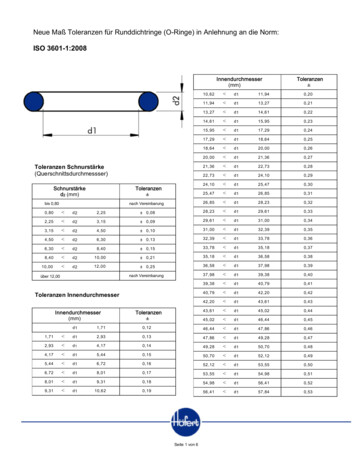
Transcription
Issue 144AUGUST 30TH, 2021I and so many of us are saddened by the passing of Nanci Griffith at 68. Some singers are good,some are truly great, and the rare few can move you to tears. Nanci Griffith was one of the rare few.Charlie Watts is no longer with us. To say we lost a giant (at age 80) would be to seriouslyunderstate the man’s titanic talent and influence. Watts was the Rolling Stones' driving force, arock-steady powerhouse, yet one who also played with an inimitable sense of jazz-informed swing.The rock world will never again be the same.We are honored to announce a new contributor: Ed Kwok. Ed spent his formative years taking thingsapart. He subsequently trained as an electrical engineer at Imperial College London in the 1980s,and got caught up in the high-end wave. His early ambition was to be an analog audio designer, buthe ended up in digital military electronics. Ed then retired from engineering and relocated back toHong Kong to concentrate on a financial career. He enjoys the computer audio space, considering itpartly science and partly high-end art.Ed founded the Asia Audio Society (asiaaudiosoc.com) with some like-minded friends, with the aim ofcrystallizing the essence of high-end audio reproduction.In this issue: Ray Chelstowski interviews Stephen Duffy, whose post-Duran Duran band the Hawkshas been an undiscovered gem – until now. J.I. Agnew begins an interview series with MartinTheophilus and the remarkable Museum of Magnetic Sound Recording. Michael Walker offers atribute to Nanci Griffith. I interview the members of rock band Augustus about Ragtime World, theirnew Octave Records album. Anne E. Johnson can’t get enough J.S. Bach, or Creedence ClearwaterRevival. Russ Welton delves deeper into subwoofer placement. John Seetoo considers the record-at-
home revolution of multitrack cassette recorders.Ken Sander works at The Psychedelic Supermarket. B. Jan Montana continues his pilgrimage toSturgis. Jay Jay French and Joe Rock wrap up the question: what do radio stations consider classicrock? Stuart Marvin ponders the future of jazz clubs. Adrian Wu continues his series on notableanalog recordings. Tom Gibbs reviews new SACD releases. Rudy Radelic begins a series onkeyboardist and composer extraordinaire Lyle Mays. Ed Kwok gives us the first part of acomprehensive overview of computer audio. The Copper A/V squad hits home with some Uberupgrades, gets no respect, makes a splash, and sits in the cheap seats.Staff Writers:J.I. Agnew, Ray Chelstowski, Cliff Chenfeld, Jay Jay French, Tom Gibbs, Roy Hall, Rich Isaacs, AnneE. Johnson, Don Kaplan, Don Lindich, Tom Methans, B. Jan Montana, Rudy Radelic, Tim Riley,Wayne Robins, Alón Sagee, Ken Sander, Larry Schenbeck, John Seetoo, Dan Schwartz, Russ Welton,WL Woodward, Adrian WuContributing Editors:Ivan Berger, Steven Bryan Bieler, Harris Fogel, Robert Heiblim, Ken Kessler, Ed Kwok, StuartMarvin, Bob WoodCover:“Cartoon Bob” D’AmicoCartoons:James Whitworth, Peter XeniParting Shots:James Schrimpf, B. Jan Montana, Rich Isaacs (and others)Editor:Frank DorisPublisher:Paul McGowanAdvertising Sales:No one. We are free from advertising and subscribing to Copper is free.– FD
Ragtime World by Augustus: New Rock fromOctave RecordsOCTAVE PITCHWritten by Frank DorisOctave Records’ latest release, Ragtime World by Augustus, offers the band’s distinctive blend ofmelodic indie, alt-rock, post-rock and other not-quite-categorizable music. Since 2014, Augustus hastoured the US and recorded five previous studio albums. Their core two-guitars-bass-drums-vocalssound is spiced with a variety of electric and acoustic guitars and amps (vintage guitar heads willhave a lot of fun identifying the various gear, all plain to hear on this high-resolution recording) andadditional sounds including lap steel guitar, mandolin and even a Mellotron.Featuring Colin Kelly (guitars, keyboards, vocals) and Jim Herlihy (guitars, mandolin, Mellotron)with John Demitro (bass, lap steel, percussion) and Forrest Raup (drums and percussion), RagtimeWorld offers an ear-catching and thoughtful variety of songs, reflecting what the band was feelingduring the onslaught of the pandemic, when, like every other band, their touring schedule came to acomplete stop.Ragtime World was recorded at Animal Lane in Lyons, Colorado in pure DSD using the Sonoma
recording system. It’s available as a limited-edition release of 1,000 hybrid SACD discs with themaster DSD layer and a CD layer. In addition, the album is available as a download bundle includingDSD64, DSDDirect Mastered 192kHz/24-bit, 96kHz/24-bit and 44.1kHz/16-bit PCM. Ragtime Worldwas produced by Nate Cook and recorded and mixed by Jay Elliott, with Giselle Collazo co-recordingand co-mixing and Jessica Carson as executive producer.The music spans a variety of moods, from the rockers “Carry All the Weight,” “Past Life” and “Leavethe Lights On” to the ethereal “Daisies,” and the spare, fingerpicked acoustic guitar of the titletrack. The instruments and equipment included a 1975 Gibson Les Paul Deluxe, 1997 FenderStratocaster electric and Guild and Martin acoustic guitars, a Hammond organ, Yamaha DX-7 andRoland JD-XI synthesizers and a Yamaha grand piano, Fender Princeton, Vox AC-15 and Silvertoneamps, and more.I spoke with Colin and Jim about the making of Ragtime World.Frank Doris: How did you guys get together? How did you decide to do the album? Did you haveany kind of concept or did it just kind of come together spontaneously?Jim Herlihy: One day we were both at a show, a friend's show at a real kind of divey bar in town.And [after a few] drinks we decided that how great would it be to like start our own band together.There was another friend who had a similar vision, and we got together and started hammering outwhat was the very first incarnation of Augustus, which has morphed considerably from [around2013] then to now. Fast forward to 2019, and we're wrapping up three years of consistent touring.Then the pandemic hit. Late last year we got approached by Octave about doing a record. RagtimeWorld came together much differently than previous records.Colin Kelly: The normal thing we do is bring songs to the table and then we tour on them. Thisrecord was different in that we basically wrote everything right before we went into the studio,rehearsed a couple of times and then just captured it on the record, as opposed to just touring [thesongs] for months and months and really living within those tunes. We had to make decisions on thefly and they're now just permanently out there!FD: Was it different recording in an “audiophile” studio where you were extremely conscious ofgetting the sound a certain way, as opposed to typical multitracking and mixing?CK: Definitely. It was eye-opening. Even just mixing in analog. It was a slower process and we'dalways worked really quickly, making a record over a weekend or in 10 days. Also, [with] having towork within a certain number of tracks, there was only so much we could do [as opposed to havingunlimited tracks to work with]. That was really cool, to be kind of held back from taking things toofar and maybe compromising the tune.FD: Did you work out the arrangements right on the spot?JH: Over years of touring in a four-piece, two guitars, bass, drums lineup and the way Colin writessongs, we had worked out a consistent sort of guitar blend through the years. We typically havespecific ideas of, if this guitar does this, the other guitar should do something else. If one guitar istexturally this way, this other guitar should maybe be texturally another way. There's latitude withinthat for interpretation, but [we have an] underlying framework that carried over into this session.
FD: I hate to use the words “post-rock” or “postmodern rock,” but I get the sense that your music isborne out of everything that's come before it. It really sounds like your own thing.JH: Thank you. We appreciate being uncategorizable! We try for that.FD: How do you come up with lyrics?CK: There are definitely some pandemic kinds of feelings on this record. [For example,] “Daisies” isabout wanting to protect your partner and dealing with those anxieties. Another song is aboutfeeling like you're feeling guilty over a past life.I don't know how other people dealt with all the free time [we had during] the pandemic, but I gotvery contemplative and realized that certain things that seemed under our control weren’t, and [theother way around].FD: Who are your influences and what bands do you like?JH: I’ve thought about this a lot. And I think my all-time favorite band is the Beatles. Maybe that's acommon answer, but you just can't take away [the impact of] their entire catalog. I like modern stufftoo. Let me call on our big Radiohead fans.FD: What are your plans for touring once that starts up again?CK: We're going to slowly try and get back to playing again. We have some big gigs coming up andin Denver we're playing an underground music showcase this month. We're going to kinda see howthings are going, and maybe we'll have to through the next year. We kind of got burned out ontouring before the pandemic hit.JH: We were basically doing the DIY thing, doing everything, making all the arrangements, and it'shard to stay creative and stay present, stay positive when so much of one's energy is put intosending e-mails and booking and [things like that] and not playing your instrument. But we'd love toget back into playing when the world is ready to have us.CK: This is definitely a time for rebalancing.FD: There’s the title of your next album!Click here to order Ragtime World by Augustus.
Moving to Computer Audio: A ComprehensiveOverview, Part OneDEEP DIVEWritten by Ed KwokAn Individual Approach to Computer AudioMention the words “computer audio” and it is likely to mean different things to different people. Totraditional audiophiles, it could mean convenient access to their music collection, be it ripped CDs orstreaming, while ultimate-performance enthusiasts would naturally marry high-resolution formatswith the latest DAC technology. The younger generation may be drawn to the user-friendly way ofenjoying music from a familiar smartphone interface. Computer hobbyists can find an additional wayto enjoy a favorite pastime via high-res music listening, and specification enthusiasts can indulge ina race to the next dB.The good news is that the hobby of computer audio can provide enjoyment to more people than justtraditional audiophiles, and in more ways than before. A larger market results in greater variety andbetter-quality products at better prices, and that is good for audiophiles. The current availability of awide range of quality DACs at the 1,000 to 2,000 price point is an example.
However, computer audio has also brought a hornet’s nest of sometimes complicated hardware andsoftware setup requirements, (sometimes unnecessary) jargon, and wildly differing and often lessthan-helpful advice. Plenty of arguments on chat groups lead nowhere, and many need attentionfrom the moderator. There was less “noise” in the heyday of vinyl, when audiophiles had moreconsensus on the direction of how to achieve the best sound from records, and what was necessaryto get there. Back then it was possible for a dedicated audiophile to audition most of the leadingsources, amplifiers and speakers, and in the most effective combinations, and this carried over tomuch of the CD era.In the world of computer audio, the greater complexity means that there are simply too manyvariables for even the most dedicated enthusiast to be an expert on everything. No one can possiblytry every type of software, computer, DAC, LAN switch, cable, power supply and so on and in allpossible configurations. Even a conceptually simple test between any of these can be hard toarrange, and A/B comparisons are either hard to do or impossible. For example, how would someonecompare the sound quality of Tidal via two different internet service providers feeding the same hi-fisystem in the same room?In a world where no one has the same goals, systems or circumstances, then everyone is right,because they have figured out what works for them. It is my belief that in the era of computer audio,the audiophile must march to his or her own beat, so if you disagree with what I am writing, good foryou!ObjectivesWhy consider computer audio? Many if not most Copper readers are experienced audiophiles with agood sounding high-end system that represents a significant investment in time and money. Equallyimportant, readers already possess the most important measuring instrument – a trained set of ears.Some may be interested in an easy way to add streaming audio to an existing system, while othersmay want to go all-in and retire the CD transport, and still others may want to move towards awhole-house network setup with different systems for different music or rooms.The desired level of technology involvement is a consideration. One should be able to enjoycomputer audio without having to do computer engineering. Yet if computer engineering is yourthing, then why not? This is, after all, a hobby, and if someone says you are wasting time assemblingRaspberry Pis but that is what you enjoy, then you know what to do. Already we can see there is notgoing to be a one-size-fits-all solution.My basic philosophy is to do what is right to maximize your own enjoyment. To make the hobbysustainable, my belief is that one should aim to retain as much of their existing system as possible.Incremental rather than wholesale changes are preferred, so that progress can be made in a step-bystep rather than a random fashion. In this article, I would like to discuss some commonconsiderations based on my own experience.A Personal NoteI may be the luckiest audiophile in the world. On a given day I could be treated to a Chopin Nocturneplayed on a Steinway Model A. How about a Bach Cello Suite played on an 1840 Kennedy cello?Maybe a Salzedo tango played on a Lyon & Healy concert grand harp? All this right in my ownlounge. You see, my family members are gifted musicians and there is often live music in the house.The experience of a concert instrument unleashed at close range is astounding – once heard, it is
hard to view recorded music in the same realm.But live music in an ideal setting does not happen on demand. I also like a variety of genres,composers and artists. Like many UK audiophiles, I spent too many evenings tuning my Linn Sondekturntable to sound euphoric on a small selection of records (in reply to my good friend Dr. AdrianWu). Imperial College, where I studied electrical engineering, had an active audio society.Manufacturers such as Meridian, Naim and Dynavector would come to demo their equipment. Theymust have thought we had good ears because as students we certainly did not have good credit.When CD arrived in 1982, it did not deliver “perfect sound forever” but it did bring the enjoyment ofconvenience that enabled each listening session to have more music and less fiddling around. (Iconcede that some folks prefer to fiddle around and that’s fine.) As CD sound quality improved overthe years, it brought a welcome level of consistency and enjoyment across genres. I began to buyCDs exclusively but kept my Linn.iTunes: the First Popular Computer AudioIn 2005, along with my first iPod came my interest in iTunes which, for me, was a defining productin computer audio. iTunes was not intended to be a high-end product and its sound quality wassufficient only for casual listening, but for the first time, I could easily browse my entire CD libraryand find any track by artist, album or song. Whereas before I felt I did not have enough CDs andoften struggled to find something to listen to, now the effect was like having a larger library at noadditional outlay. I transferred my entire CD collection to the computer in lossless formats and sinceI kept my originals, I could use the CD transport whenever better sound was required. But, Ithought, what if there could be an iTunes with sound approaching or even comparable to a CDtransport?High-Resolution Computer Audio SoftwareBit-for-bit computer audio software such as the JRiver Media Center (PC) and Audirvana (Mac)promises to combine iTunes-like easy browsing with much improved sound quality. They were easyto set up and operate – if you could install Word, you could handle JRiver. When I changed to JRiverin 2010, computer audio sound quality was some way below a CD transport, but the combination ofan entire music library controlled from the listening chair and with good enough sound quality waspersuasive.JRiver had two key audiophile features. Memory playback involves the pre-loading of an entire trackfrom a hard drive to semiconductor memory before the first note is played. Many things happenwhen music is read from a disk drive. The disk spins to the angle where the track is stored, powerfulmotors move the magnetic heads to the correct position, and the data is read, checked for readerrors and re-read if necessary. With so much going on, some audiophiles could even heardifferences between different models of hard drives. With memory playback, however, the computermerely needs to feed the track from memory to audio hardware during playback. By decreasing thework performed in real time, the sound quality could be improved.JRiver could send the audio data directly to compatible audio hardware – at the time often aprofessional sound card such as a Lynx or ESI – via a technology used in studios called ASIO (AudioStream Input/Output) that gave much better sound because it bypassed Windows’ multiple layers of
audio processing. Microsoft’s more recent WASAPI tries to do the same thing but does not sound astransparent in my experience. With user-friendly bit-perfect software like JRiver, computer audiobegan to gain traction.Building a Music LibraryThe availability of a digital music library is, of course, critical. Most audiophiles have hundreds ofCDs or even thousands, so this can form a good basis. Transferring (“ripping”) CDs to a computer forpersonal use is legal and accepted (see About Piracy - RIAA). Exact Audio Copy is a popular softwareutility (see Tom Gibbs' article in Issue 143), and, for whatever software you might decide upon, alossless audio format, usually FLAC or AIFF, should be chosen. The software should be set up toautomatically fill in the fields for artist, album, track and genre by matching the CD with an onlinedatabase (the computer needs to have internet access during ripping), but manual editing issometimes required. Ripping 1,000 CDs sounds daunting, but it is not that hard once you set up aproduction line.One can of course also purchase tracks, albums and entire libraries online, and some of my favoritealbums are now available in hi-res. However, I think there is something wrong with having topurchase the same music three times – the first time for vinyl, the second time for CD and now forhi-res, so I have kept my purchases to new releases.Nowadays, by far the biggest source of music for computer audio is hi-res streaming. I am a fan ofTidal HiFi because it caters to my musical tastes (classical and jazz) and the audio quality isexcellent. If Tidal suits you, there is no need to rip your CDs. Simply take out a subscription to TidalHiFi and enjoy a library of 60 million tracks at CD-quality or better. Tidal hi-res is streamed in MQAformat and my experience has been very positive. The big announcement in hi-res streaming thisyear (2021) was the availability of Apple Music in hi-res, and audiophiles will need to figure out howbest to use it and whether it has competitive sound quality.USB DACsComputer audiophiles have long recognized that computers are bad places in which to put audiohardware such as DACs. The inside of a computer is an extremely noisy electrical environment andthe switching power supplies are designed for electrical efficiency and not sound quality. A fewmanufacturers have made efforts to design audiophile sound cards but with mixed results.When high-end USB input DACs became available that allowed computer audiophiles to move theDAC outside of the computer, sound cards went out of fashion overnight. USB DACs furtherimproved once engineers figured out how to turn what is basically a dirt-cheap data link into a highend interface. Nowadays pretty much all USB DACS use asynchronous transfer, which improvessound quality by increasing the isolation between the DAC and the computer.Directly Connecting a Windows or MacOS Computer to a DACAt this point, we have a PC or a Mac running bit-perfect software directly connected to a USB DAC.Sound quality has improved but it is probably still way below a CD transport. Why is that?If you open Task Manager on a PC or Activity Monitor on a Mac, you will see its doing hundreds of
tasks at the same time. All those tasks enable office workers to get their documents done, workfrom-home folks to do video conferencing, students to research their homework and everyone else towatch YouTube and play games at the same time. Very few tasks have anything to do with audio, andevery unnecessary task is detrimental to sound quality because it makes the computer work harderfor no gain. How can Windows or MacOS possibly compete with a dedicated CD transport that isdesigned specifically for music playback?You could try using “optimizing” software that streamlines Windows or MacOS by shutting off someunnecessary tasks. But shut off too many and the computer stops working. It is simply impossible toturn Windows or MacOS into something they are not.Running hundreds of concurrent tasks requires powerful processors. Look under the hood of anyrecent computer, even a laptop, and you will see at least a quad-core processor that uses so muchpower it needs fancy cooling. All that power is consumed by billions of transistors switching on andoff at mind-boggling speeds. Imagine 30 billion tiny light switches inside your computer flipping onand off three billion times a second, happily generating electrical noise and RF interference.Audiophile ComputersIf you must use Windows, you can consider an “audiophile computer.” Potential European suppliersinclude Audio PC Shop and Pachanko Labs, and some suppliers use chassis from a company calledHDPLEX.Some argue that equipment upstream of an asynchronous USB DAC cannot affect sound becausebits are bits. As audiophiles, you must trust your ears.Look inside an audiophile computer and you should see a gaming-grade computer motherboard.(The best-quality motherboards are designed for eSports.) The motherboard may have somemodifications, such as higher quality clock chips, to make it more suitable for audio. You should finda medium-power processor – appropriate for the job and with reduced electrical and fan noise.Quality solid state drives such Samsung are standard. No audio engineer expects you to drive yourhigh-end DAC from a consumer motherboard so look for a separate audio-grade USB or SP/DIF/AESboard. A linear power supply is preferred but adds considerably to the cost. Decent caseworkcompletes the picture. If you must use MacOS, your options are effectively limited to Apple’s productline.With an audiophile computer, sound quality has improved to the limit of what can be done with acomputer directly connected to a DAC, but in my experience may still be below what can be heardfrom a high-end CD transport.The fundamental problem is that the PC industry does not make computers designed for audiophiles.Development and tooling costs are high and factories are running flat-out, shipping 500 office andgaming computers every second. To them, the audiophile market is but a rounding error – it does notpay to make computers designed for us. The audiophile computers I see advertised, even thoseincorporating significant engineering, are still office or gaming computers at heart. (There is abetter place for these in a computer audio system, see my comments in the next installment.) In thesame way that a heavily-modified production car still cannot match a specialist racer up Pikes Peak,a computer based on standard parts will have difficulty matching the sound quality of a CDtransport.Linux, and Streamers Designed for AudioIf Windows or MacOS involves an uphill battle, why not find a better alternative?
Streamers (or network players) can play music from your ripped CD library stored on disk ornetwork drive and from your online sources such as Tidal hi-res, all at high-end sound quality. Theyconnect to your existing DAC, can be controlled from iPad, smartphone or another device, and arenot that expensive. How is this possible? Enter the Linux operating system.Unlike Windows or MacOS, Linux is open sourced (any computer engineer can work with it) andconfigurable for optimum performance for each application. Your router runs Linux, and so doesyour smart TV, smart doorbell and your Mercedes. Did I mention SpaceX rockets? Linux’sconfigurability means high-end manufacturers can offer minimalist software configurations that doaway with all those sound-quality-sapping superfluous tasks.With much less processing work to be done, a genuinely lower-power processor will suffice. In astroke of good fortune, it turns out that smartphone processors are very suitable for audiostreamers. Smartphone processors are low-power (consuming only a few watts), low-noise, andsuitable for linear power supplies at reasonable prices.If a streamer satisfies your needs, it is hard to argue why you would need anything more.In Part Two of this series, we’ll discuss the Raspberry Pi phenomenon, endpoint streamers, Roon andhow to optimize its use, why computer switches and networks can matter, why Wi-Fi can be asonically superior alternative, and other considerations.Header image: the inside of a Denafrips Terminator II DAC.
Cassette Multitrack Recorders: the OriginalDIY Studios in a BoxDEEP DIVEWritten by John SeetooDuring the 1960s and 1970s the notion of a personal studio for an artist to record demos or possiblymasters of their songs was still an expensive prospect, involving reel-to-reel multitrack recorders,mixing consoles, and other equipment. Artists who recorded at home to fine-tune their material wereall famous musicians. Les Paul, Pete Townshend, Paul McCartney, Stevie Wonder, and ToddRundgren are among the few who decided to play all of the instruments, and engineer and producerecords from those home studio efforts during that era.However, when Bruce Springsteen released his highly acclaimed 1982 solo acoustic record,Nebraska, much publicity was made over the fact that Springsteen had recorded it at home on aTASCAM 144 Portastudio cassette 4-track unit with a couple of Shure SM57 microphones. Thus,instant credibility was achieved for a novel invention by TEAC’s TASCAM division and an entirelynew DIY market was born.Essentially, the Portastudio used the two left and right channels on each side of a standard audiocassette tape, with its recording head configured to allow for all four tracks to be recorded upon inthe same direction (as opposed to flipping over the tape to play both “sides” of cassette on astandard stereo playback machine). With its four VU meters and basic two-band equalization,panning, gain and volume controls all built into a single small desktop unit, the Portastudio 144
made DIY bedroom recording finally available to thousands of musicians, songwriters and producers.(Although home-use four-track reel to reel tape machines like the classic TEAC 2340, A-3340 andA-3340S had been available since the 1970s, their cost put them out of reach for most musicians.)Three years after the unit’s 1979 debut at AES, TASCAM released the Portastudio 244, which hadparametric EQ, DBX noise reduction, varispeed, and simultaneous recording capability on all fourtracks.Portastudios were the ideal songwriting tool for home experimentation or for bands on the road.Cassettes were relatively cheap, easy to store, and delivered good-enough sound to be used forcommercial music releases, and to be used in conjunction with more professional recording formats.Rival manufacturers including Fostex, Yamaha, Marantz, Akai and Vesta would soon follow, hot onTASCAM’s heels with their own portable multitrack studio-in-a-box offerings.In 1986, TASCAM released the Portastudio 246, featuring six channels and a higher 3.75 ips (inchesper second) tape speed for better sound quality.TASCAM Portastudio-recorded tracks would subsequently pop up on many singles and albums fromartists throughout the 1980s and 1990s. Some of the better-known ones include:“Kiss From A Rose” – SealNew York (various tracks and original demos) – Lou ReedSmile From The Streets You Hold – John FruscianteEnter the Wu-Tang (36 Chambers) – Wu-Tang ClanFostex had its own line of compact 4-track cassette recording units that competed with TASCAM. In1983 Fostex launched the X-15, which was about the size of a hardcover book and pared down thecontrols to a bare minimum, while still maintaining the primary recording and playback functionsrequired by most users. Its main advantage over the Portastudio was its genuine portability – it alsoworked on batteries, thus making it an excellent multitrack field recording unit. TASCAM’s PortaOne, a competing battery-powered unit, would not reach the market until the 1990s.Apart from their cassette multitrack units, Fostex also created the first 16-track half-inch reel-to-reeldeck designed for home studio recording: the B-16. Its popularity was so great that at one point,Ampex had a problem meeting demand for the half-inch-format 456 recording tape that the B-16used. The B-16 became the cornerstone of Be-Bop Deluxe founder Bill Nelson’s home studio in theUK. He used it to record and release some two dozen or more albums.Yamaha’s MT2X, MT50 and other MT Series multitrack cassette recorders competed head-to-headwith the Fostex X-15 as battery-po
the Lights On” to the ethereal “Daisies,” and the spare, fingerpicked acoustic guitar of the title track. The instruments and equipment included a 1975 Gibson Les Paul Deluxe, 1997 Fender Stratocaster electric


